Jason Statham's 'The Beekeeper' Workout: A Total-Body Burnout for Six-Pack Abs
- Oops!Something went wrong.Please try again later.
There’s a reason why Jason Statham is an action movie stalwart. Before becoming a leading man, the English actor studied karate and kickboxing. He also competed at the 1990 Commonwealth Games as part of Britain’s national diving team. Suffice to say, Statham was a physical specimen and skilled fighter before ever stepping in front of a camera. And that hasn't faltered, even at the age of 56.
That meant the first time Statham was asked to take his shirt off and crush a few pullups in a scene, there wasn’t a mad dash to put on last-minute muscle. Instead, when Statham needs to add the finishing touches to his physique and sharpen a particular skill set, he leans on the principles he's honed through martial arts training. When the action is particularly intense, Statham brings in a trainer, but it’s not your ordinary strength and conditioning coach.
For The Beekeeper, a revenge thriller helmed by David Ayer, Statham wanted an edge for his vengeance-fueled character Adam Clay. As in many of his past roles, the actor is front and center for the majority of the fight sequences, and collaborated closely with the 87eleven stunt team led by Jeremy Marinas, who's worked on the entire John Wick franchise.
View the original article to see embedded media.
“The goal was to do scenes that were very visceral and shocking, while being believable,” Statham tells Men's Journal. “This wasn’t about the dazzle. This was about the violence and the efficiency."
So the actor brought in a trainer who's familiar with both.
James Moontasri is a two-time taekwondo national champion and former welterweight in the UFC. Following his retirement from competition, the fighter transitioned into the world of stunts. He first crossed paths with Statham on Hobbs & Shaw, and after some productive work together, the two stayed in touch. Knowing that The Beekeeper was going to be a heavy lift for him, Statham reached out to Moontasri when the time came.
We worked out with Moontasri to get a peek into the dynamic training Statham did to become Adam Clay in The Beekeeper.
View the original article to see embedded media.
Enviably Fit at 56: How Jason Statham Trained for The Beekeeper
Statham and Moontasri got together 12 weeks before filming began, in a four-floor facility in London.
“Jason stays in phenomenal shape year round on his own, so he showed up in a great place,” says Moontasri. “That makes my job easy and, in the end, when it comes to Jason, I’m just there to help him execute on what he already knows.”
While Statham is consistent, his regimen is anything but routine. On any given day, after a stretching session, the first hour can comprise weights, advanced plyometrics, boxing, or stability ball exercises from Sports Science Lab for power, stability, and explosiveness.
“The work begins around five in the morning and, sometimes, there wouldn’t need to be words exchanged between us,” says Moontasri. “I could just tell when he wanted to start by hitting something, and I’d pick up the pads.”
View the original article to see embedded media.
There's almost always an hour dedicated to rolling on the jiu jitsu mat. “The benefit of working with someone like Jason, who's skilled in martial arts, is we can train for three or four hours without anyone getting bored,” Moontasri says. Sometimes hours would be spent drilling the choreographed fights that Statham would throw as Adam Clay.
“Jason likes to execute everything he does to perfection," says Moontasri. "That means throwing a kick or a punch for hours for it to be flawless in the sequence.”
Since the actor has to deliver dialogue and a performance, as well as action, the strikes have to be more than instinctual.
Moontasri ensured Statham had plenty of rest to ensure he was ready for the heavier physical lifts.
There’s one exercise that Statham needs no assistance on at all, and that’s pullups. “Jason can crush pullups and muscleups like crazy, and he does them on the gymnast rings,” says Moontasri. “He’s got a routine he'll do on his own before we work together, and it’s pretty intense. I think being able to push yourself in isolation is a massive advantage.”
View the original article to see embedded media.
Jason Statham's The Beekeeper Workout: A Total-Body Burnout for Six-Pack Abs
Directions
This an example of the training Statham and Moontasri did leading up to The Beekeeper. The only equipment you need is a pullup bar, rowing machine, and stability or Swiss ball.
Do 4 sets of the A block exercises following the indicated reps, time, or distance for each, resting 15 seconds between exercises and 1 minute between rounds. Then do 4 sets of the B block of stability ball exercises, performing each for 45 seconds, resting 15 seconds between exercises and 2 minutes between rounds. Complete all reps on the final set to failure.
The point of the stability ball exercises is to promote explosiveness, increase mobility, and improve your mind-body connection. Building abs like Statham doesn't hurt either.
Note: To up the intensity, once you get comfortable, feel free to push the tempo. You can also do additional shadowboxing during the 2-minute breaks between B Block sets.
A1. Pullups x 15 reps
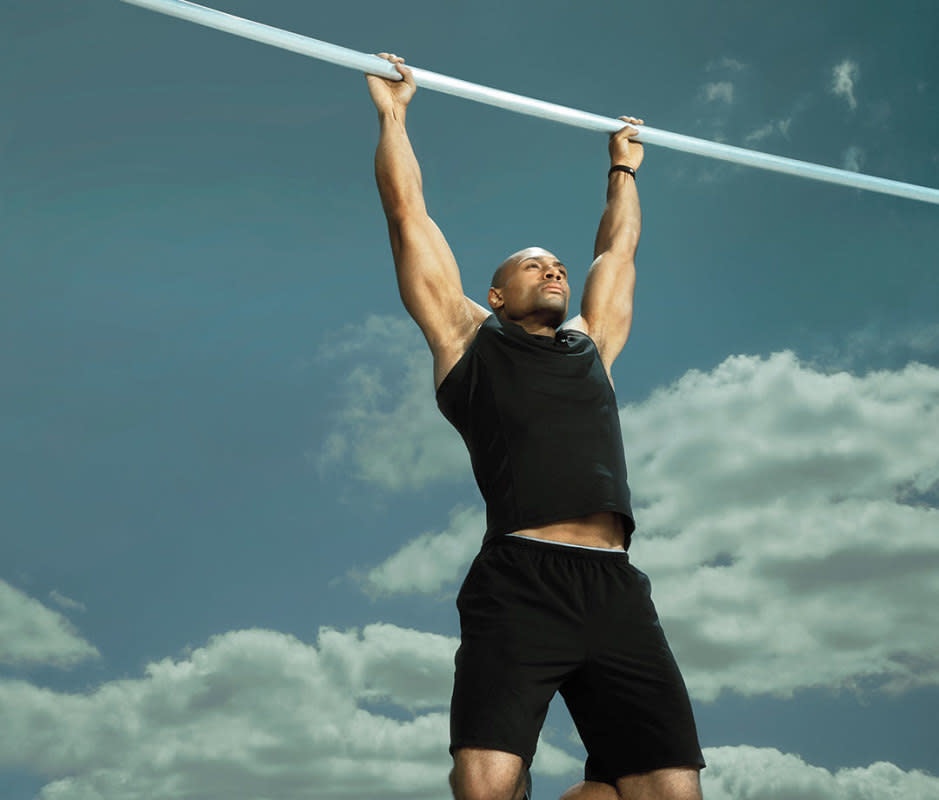
James Michelfelder & Therese Sommerseth
How to Do It
Place your hands shoulder-width apart using an overhand grip on a pullup bar, to start.
Initiate the movement using the lats and lower traps by pulling your shoulders down your back from the dead hang position.
Inhale, brace your core and engage your glutes, as you drive up toward the bar by pulling through your elbows, not your hands, Imagine you're tucking your elbows into your pockets. This will place most of the emphasis on the upper and mid-back, and away from your grip strength and forearms. Avoid the urge to swing or use momentum to keep this strict.
Exhale at the top of the movement. If you're tall and have long arms, you might not be able to get your chest over the bar; that's ok.
Slowly lower with control to the dead hang start position. That's 1 rep.
A2. Row x 1,000 meters
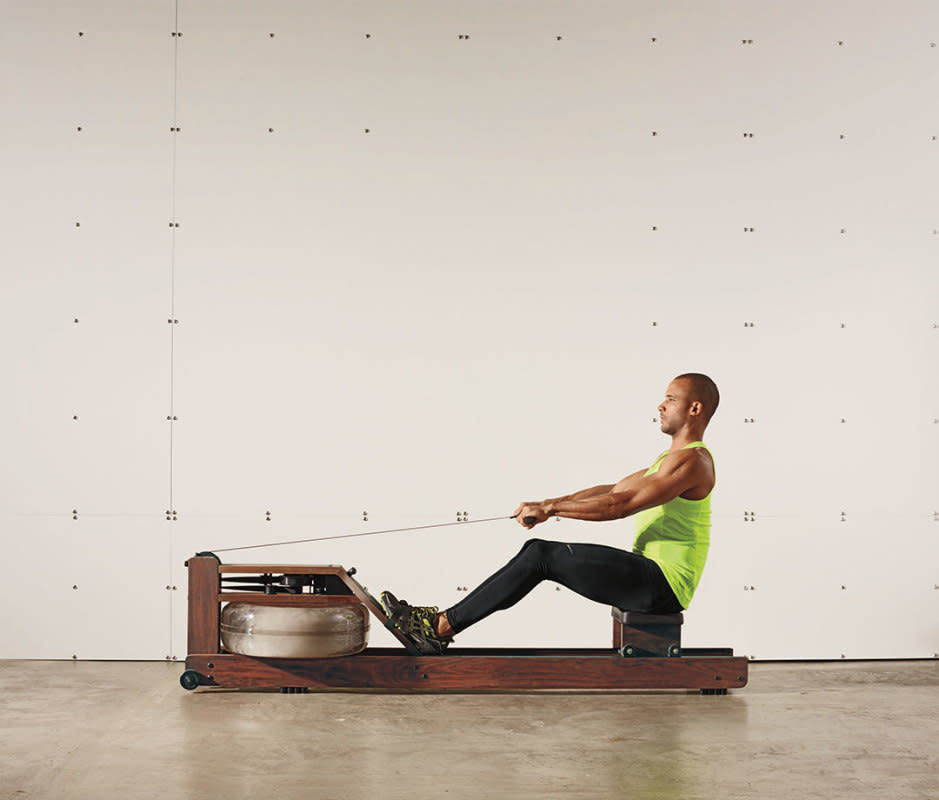
Justin Steele
How to Do It
Adjust the height of the heel slide and tighten the straps across your feet. Place your hands on either side of the handle using an overhand grip, to start.
Begin with the catch, with arms straight, head neutral, knees bent, and shoulders level at the front of the machine. Shins should be vertical and your shoulders should be slightly in front of your hips, so you're leaning in but maintaining a tall torso.
Transition into the drive by driving your feet into the heel slides and extending your legs. Your torso will become more upright and your hips will swing back, then you'll bend your arms to bring the handle to your lower ribs. Fight the urge to power the drive with your arms. Think of this like a power clean, where the movement begins with your legs, you accelerate through the body, then your arms come into action.
In the finish position, you'll have a slight lean back with legs fully extended.
In the recovery position, you'll reverse this entire sequence: Move the hands away from the body first, then pivot from the hips to get into the strong lean forward (shoulders in front of hips) and finally break the knees to end in the starting “catch” position. That's 1 rep.
A3. Shadow Boxing x 3 minutes
View the original article to see embedded media.
How to Do It
This is a freestyle exercise in which you'll alternate among the common types of punches:
Jab: Use your non-dominant hand to punch straight ahead.
Cross: Use your rear, dominant hand to punch straight ahead. Use your legs and torso to pivot and generate more force and power.
Hook: Use either hand to come at your target from the side, using your hips and legs for power. The movement travels out from your shoulder, but don’t let your elbow travel out wider than your shoulder; keep it compact.
Try these sequences:
Jab-cross
Jab-cross-hook
Jab-jab-cross
Jab-hook-cross
Cross-hook-cross
Hook-cross-hook
Jab-cross-hook-cross
Jab-cross-jab-cross-hook-hook
B1. Stability Ball Hamstring Curl x 45 sec.
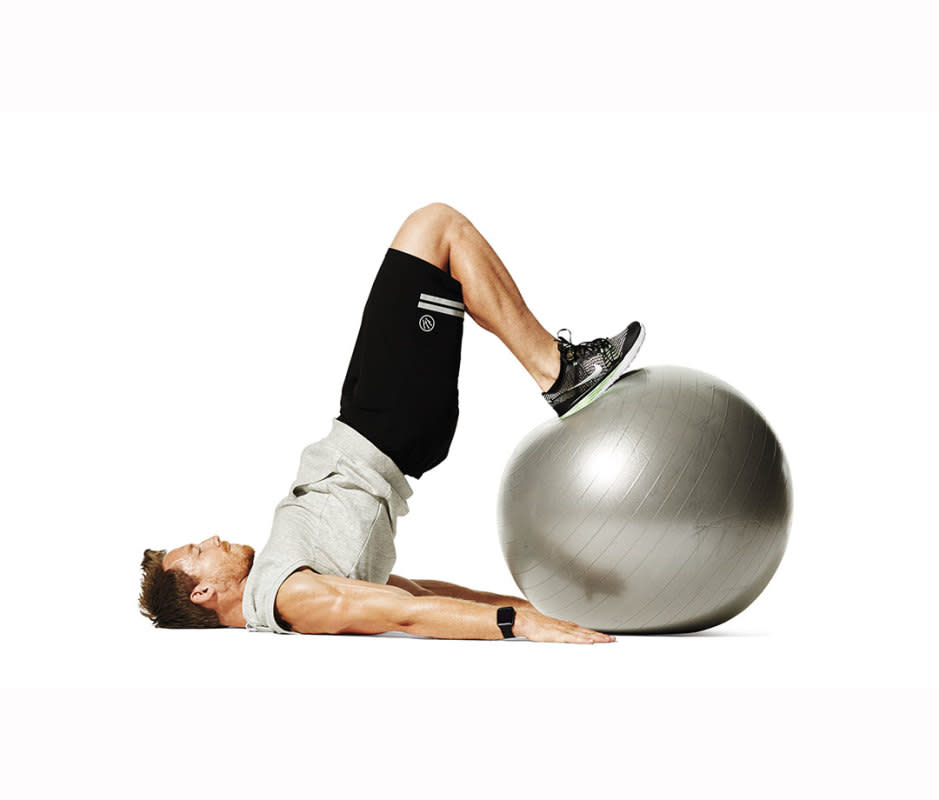
James Michelfelder
How to Do It
Lie on your back on the floor and rest your heels on a stability/Swiss ball, to start.
Brace your abs and drive your heels into the ball to raise your hips into the air.
From the top of this hip extension, bend your knees and curl your heels toward your butt, rolling the ball back toward you (shown above).
Pause briefly at the top, then slowly return legs with control to the start position. That's 1 rep.
B2. Stability Ball Rotational Knee Tuck x 45 sec.
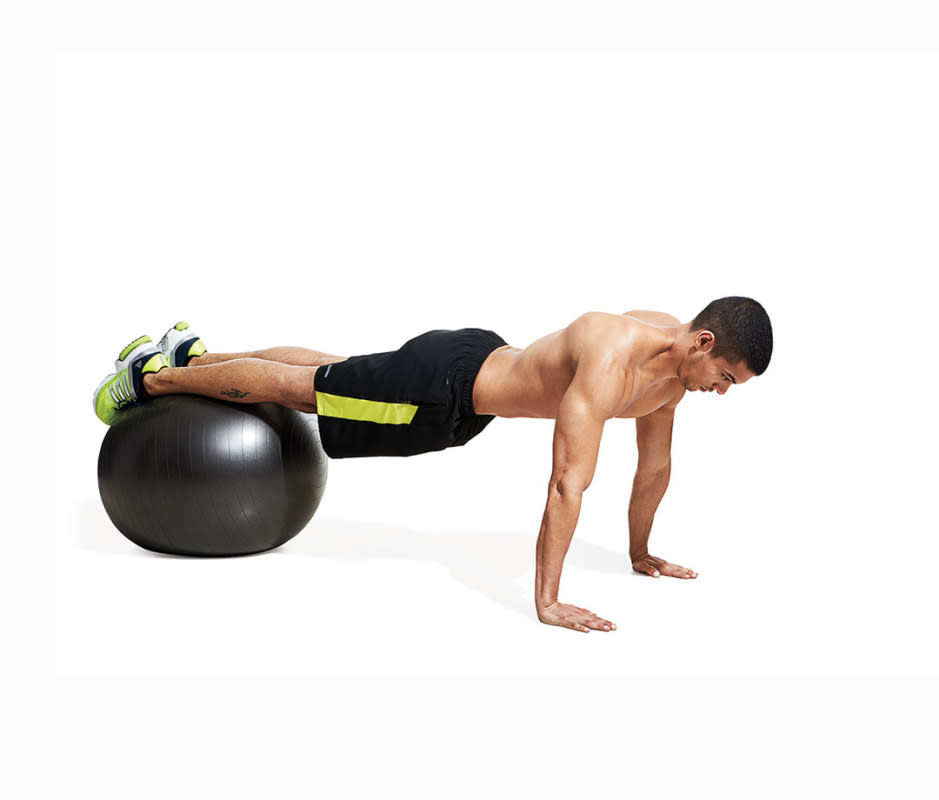
Beth Bischoff
How to Do It
Begin in a high plank position with hands on the ground and legs elevated on a stability ball positioned against your shins, to start (shown above).
Engage your left obliques to draw your knees in toward your left side, rotating through your hips but keeping your weight distributed evenly through your arms and your knees glued together. The ball will roll slightly as you tuck your knees up.
Immediately use your abs to reset briefly into a bear plank position—knees under hips—then engage your right obliques to draw your knees in toward your right side.
Once you're comfortable with the movement, pick up the pace so the twist from side to side is fluid.
B3. Stability Ball Plank Tantrums x 45 sec.
How to Do It
Begin in the same start position as stability ball rotational knee tucks, to start.
Engage your core and glutes, then start kicking your legs in short, fast motions against the ball. It should feel like you're dribbling it with your shins.
Keep the speed and intensity up throughout the duration.
B4. Stability Ball Plank x 45 sec.
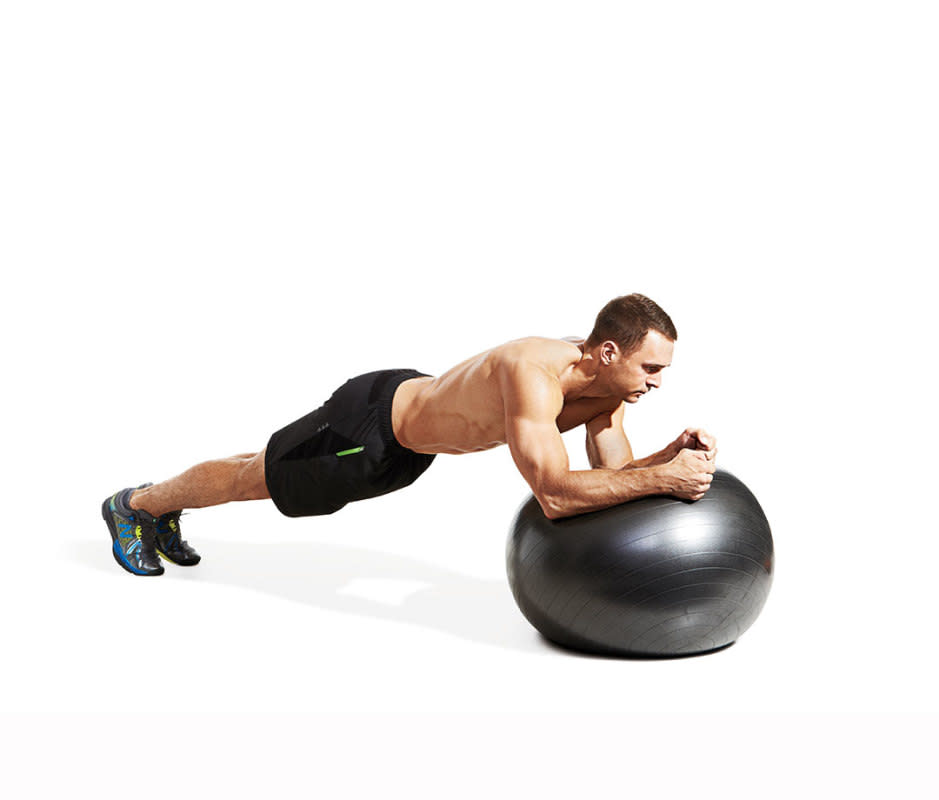
Beth Bishoff
How to Do It
Get into a plank position with elbows on the stability ball and toes on the ground, to start.
Keep your body in a straight line and your core engaged.
Focus on generating tension in your core by drawing your elbows down toward your feet. During the hold, inhale and exhale for counts of five.

